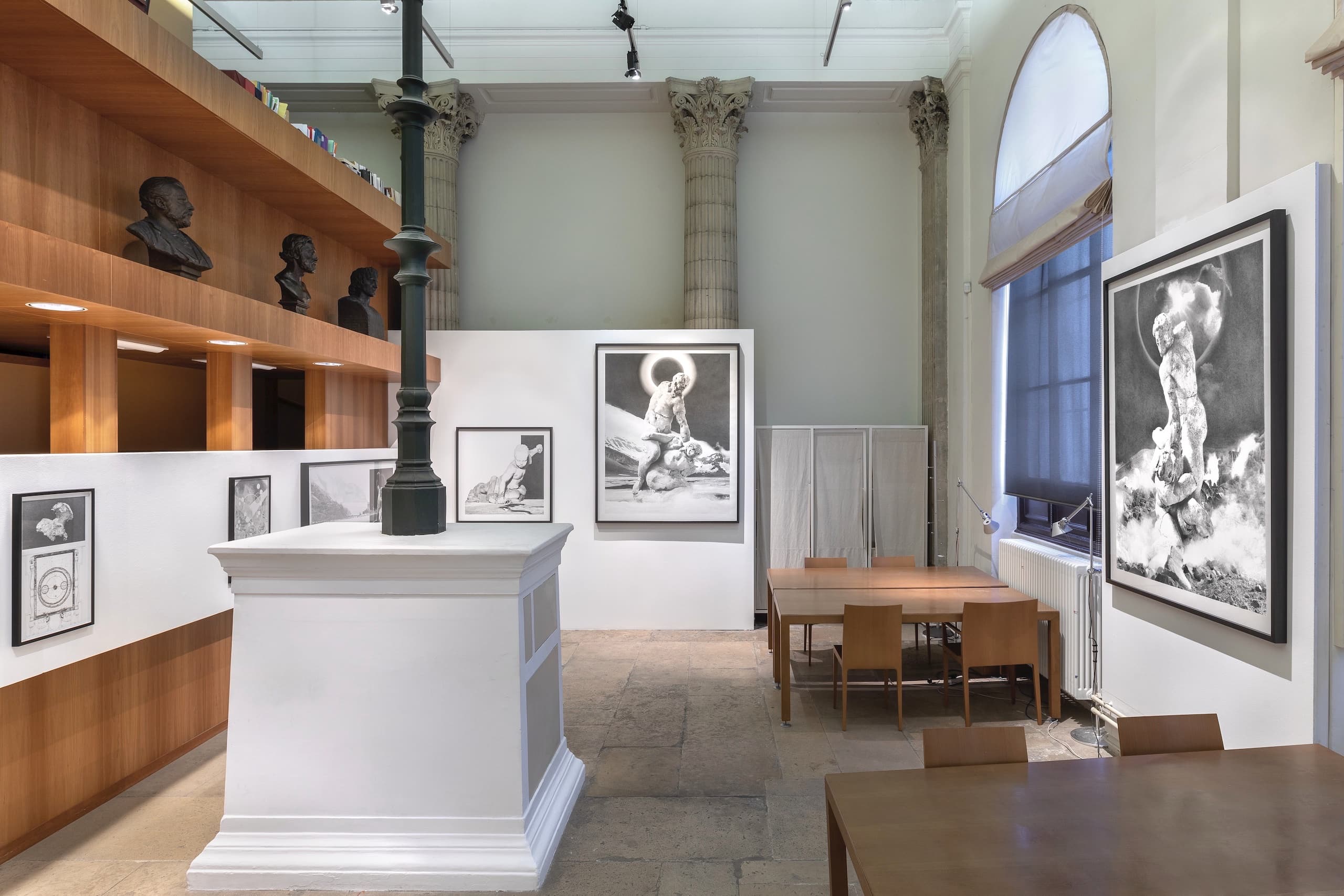JEAN BEDEZ
Né en 1976 à Colmar, France
Vit et travaille à Paris et Marseille
Diplomé diplômé des Beaux-Arts de Paris en 2001, il reçoit dès 1999 le prix artistique de peinture Lucien Quintard à l’académie de Stanislas de Nancy pour un travail graphique conceptuel questionnant la notion d’œuvre autographe et le rapport au Temps qu’il ne cessera plus d’interroger.
Son travail a notamment été présenté au Crac Languedoc Roussillon à Sète, au Musée des Arts Décoratifs de Paris, au Museo Villa dei Cedri à Bellinzone (Suisse) ou encore au Palais de Tokyo.
JEAN BEDEZ
Born in 1976 in Colmar, France
Lives and works in Paris and Marseille
A 2001 graduate of the Beaux-Arts de Paris, Jean Bedez was awarded the Lucien Quintard prize for painting, in 1999, from the Stanislas Academy in Nancy for a conceptual graphic work in which he examines the notion of a signature gesture and our relationship to Time, which he will continue calling into question throughout his work.
He has exhibited at the CRAC Languedoc Roussillon (Sète), the Musée des Arts Décoratifs (Paris), the Museo Villa dei Cedri (Bellinzone, Switzerland), and the Palais de Tokyo (Paris).
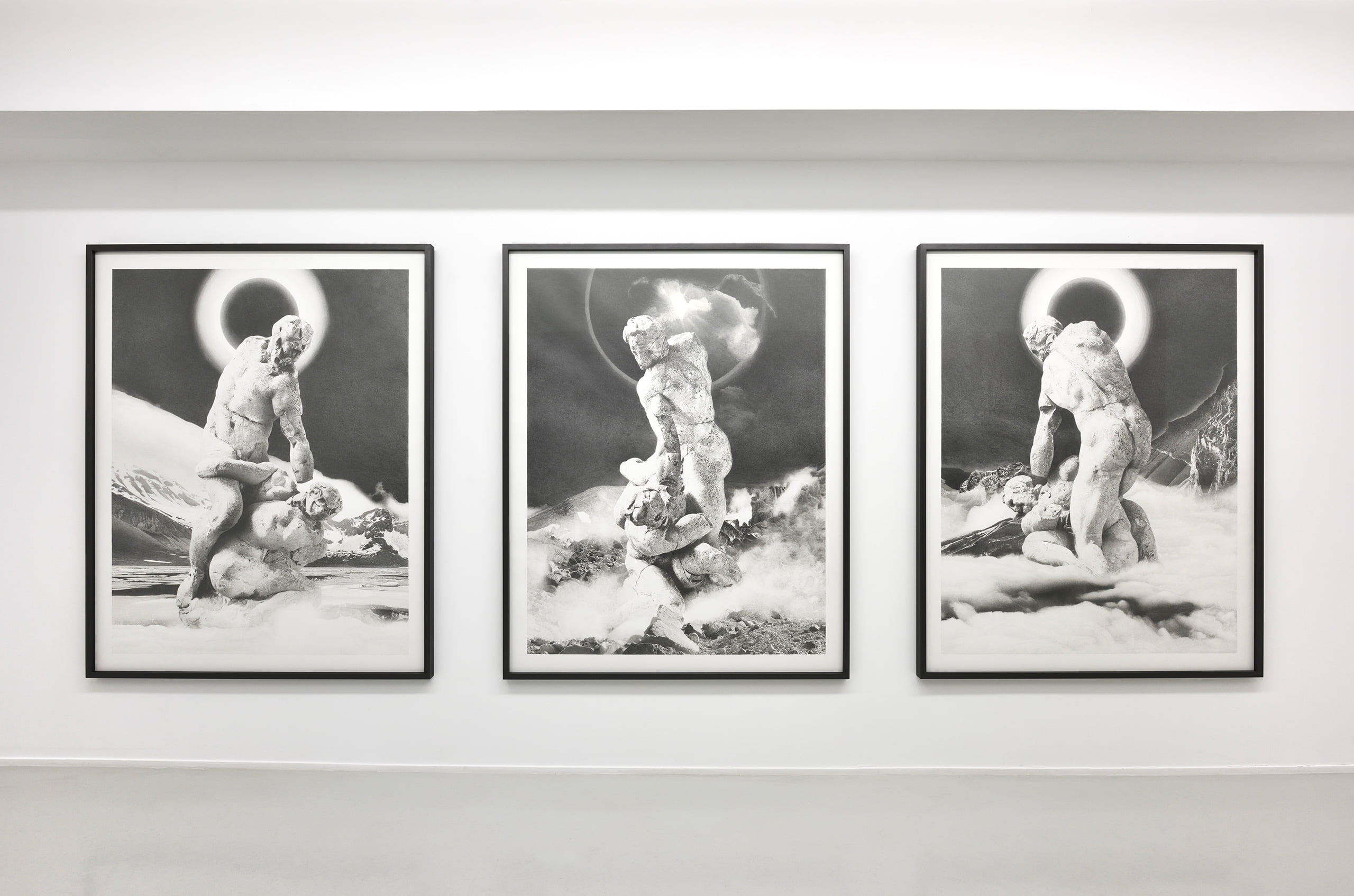
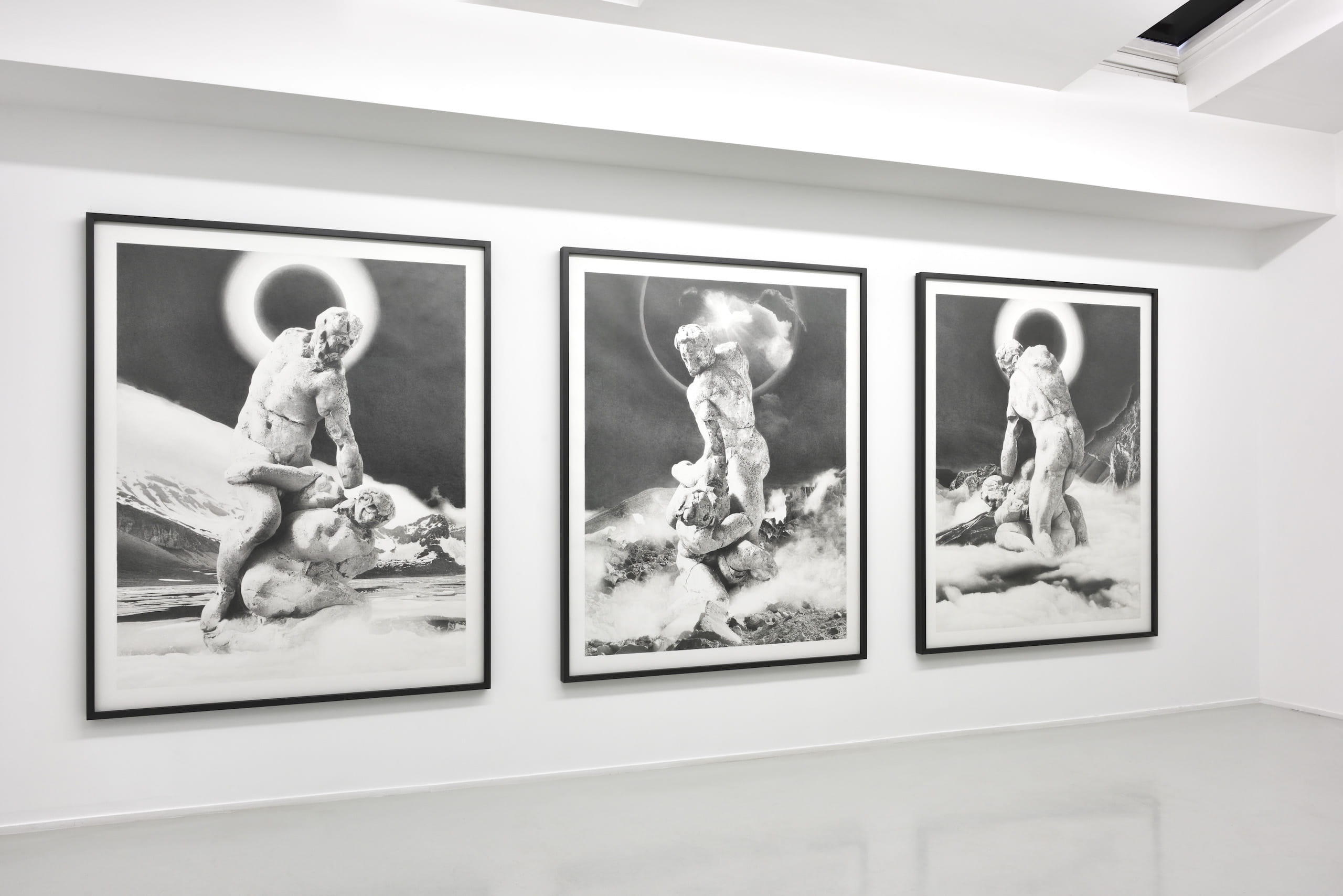
Hercule et Cacus / Hercule and Cacus, 2020
Dessin à la mine de graphite Faber-Castell, papier Canson 224 g/m2
Graphite drawing Faber-Castell on Canson paper224 g/m2
Chacun / Each: 181,5 x 145,5 cm (71 1/2 x 57 1/4 in.) encadré / framed
Le triptyque met en scène sous trois angles différents (de face, de profil, de dos) le combat mythologique d’Hercule et du géant Cacus, fils de Vulcain qui avait osé lui dérober quelques-uns des bœufs appartenant à un butin ancien. Jean Bedez explore de nouveau l’univers des mythes (série de 2018 Pluton, Mars, Mercure, Jupiter) et approfondit sa réflexion sur l’art du combat inaugurée en 2014.
Dans cette gigantomachie recréée et réinventée d’après une statue de Michel Ange, Jean Bedez continue à se nourrir d’un dialogue fécond avec les maîtres anciens en s’inspirant librement d’un sujet traité par la poésie latine, la sculpture florentine de la Renaissance ou l’art du dessin au 18ème siècle.
La stature monumentale du héros mythologique, colosse aux muscles contractés par la lutte, domine le monstre terrassé à ses pieds. Une nuit opaque obtenue par des noirs très denses, contrastant avec la pâleur de brumes diffuses, enveloppe un chaos rocheux. Une rotation du regard fait surgir trois visions du même paysage où émergent successivement trois des quatre éléments. L’eau gelée d’un lac, l’élément tellurique des montagnes, la légèreté aérienne des nuages de brouillards. Un astre noir infusé dans un effet d’éclipse par un halo de lumière, surplombe la tête du héros à l’instar d’une auréole.
Le combat acquiert une dimension cosmologique. Cet Hercule solaire écrase une figure monstrueuse que le mythe associe à l’obscurité des cavernes et à la noirceur des fumées. Dans un paysage des origines de la création, la lumière surgit métaphoriquement des ténèbres, les astres et les éléments participent au triomphe du demi-dieu en intensifiant la dramaturgie de la scène.
The triptych presents from three different angles (front, profile, and back) the mythological fight between Hercules and the giant Cacus, son of Vulcan, who had dared to steal from Hercules. Bedez again explores the universe of myths (as in the 2018 series Pluto, Mars, Mercury, Jupiter) and deepens his reflection on the art of combat inaugurated in 2014.
In this recreated, reinvented gigantomachy based on a statue by Michelangelo, Bedez continues a fertile dialogue with the Old Masters by drawing inspiration from a subject treated by Latin poetry, Florentine sculpture of the Renaissance, and the eighteenth-century drawing.
The monumental stature of the mythological hero, a colossus, his muscles straining with the struggle, dominates the monster, struck down at his feet. An opaque night, obtained by very dense blacks, envelops a rocky chaos, contrasting with the paleness of diffuse mists. Looking around, three visions of the same landscape appear, from which emerge three of the four elements: the frozen water of a lake, the telluric element of the mountains, and the aerial lightness of clouds of fog. A black star, eclipsed by a halo of light, overhangs the hero’s head like a halo.
The fight has a cosmological dimension. This solar Hercules crushes a monstrous figure that mythology associates with the darkness of caves and the blackness of smoke. In a landscape evoking the origins of creation, light metaphorically emerges from the darkness, the stars and the elements participating in the triumph of the demigod by intensifying the drama of the scene.
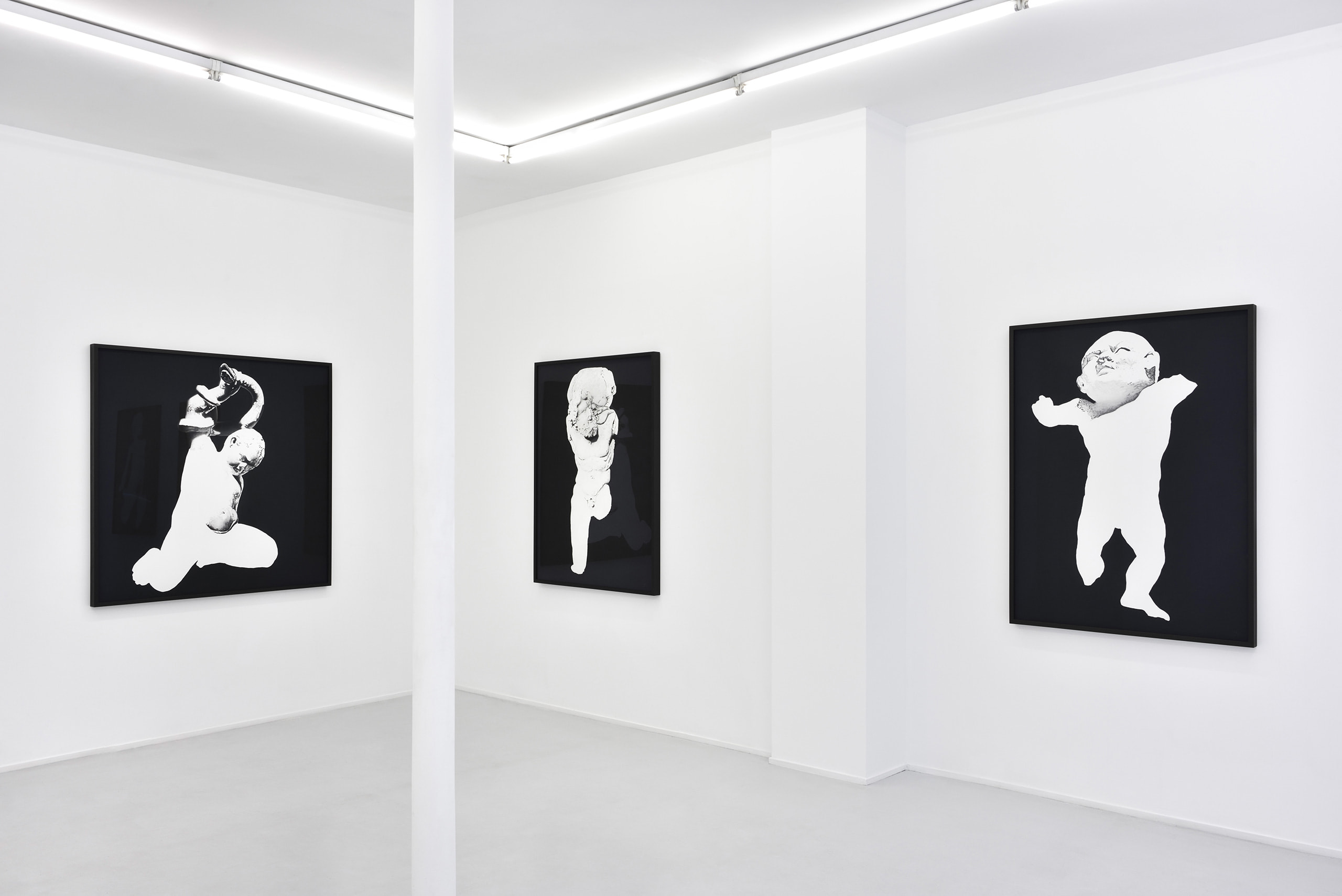
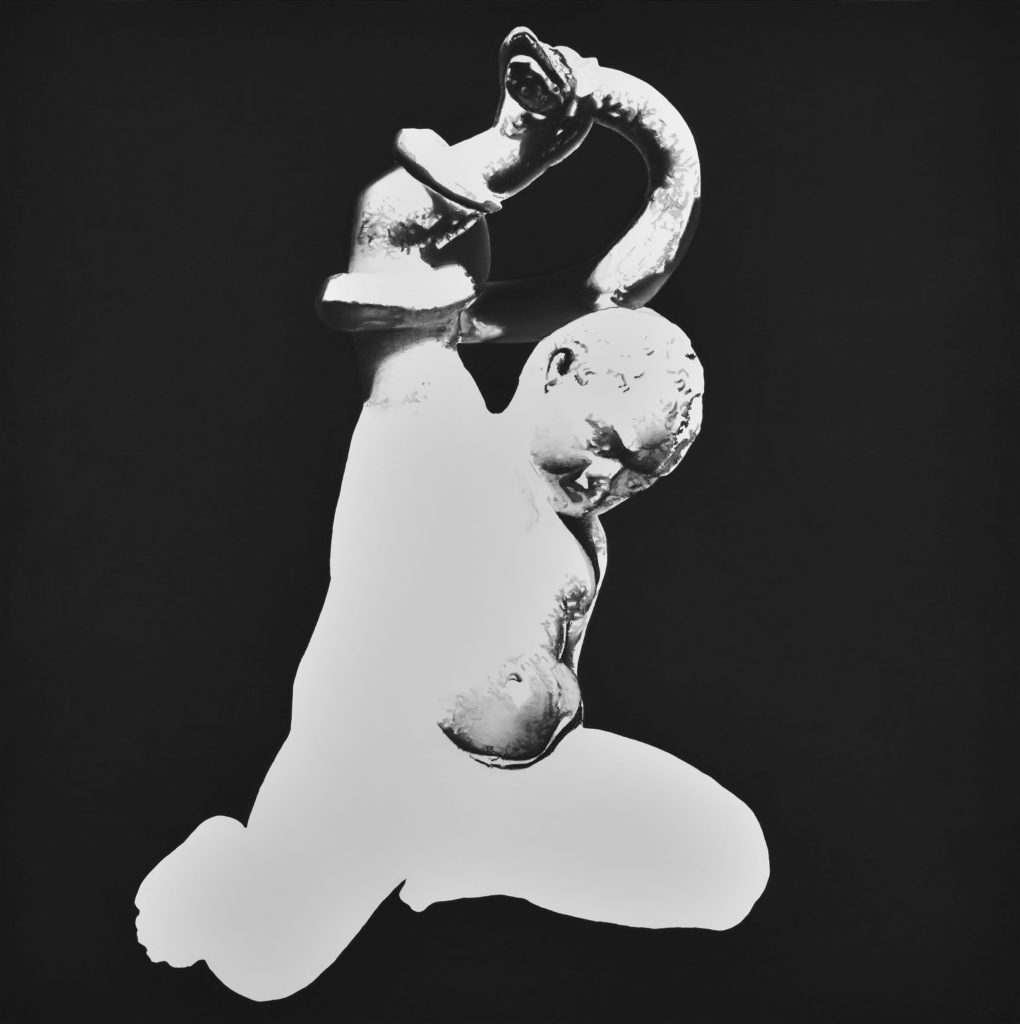
Hercule enfant étouffant les serpents (I) / Hercules as a Child Choking the Snakes (I), 2021
Dessin aux pigments naturels et fusains, papier Canson 224 g/m2
Drawing with natural pigments and charcoal, Canson paper 224 g/m2
133 x 133 cm (52 3/8 x 52 3/8 in.) encadré / framed
Dans ce dessin exécuté d’après une statue romaine du 2ème siècle avant J.-C., Hercule enfant immortalisé dans la posture du lutteur, s’arrache du sol dans une diagonale de l’effort, pour repousser le serpent, à la gueule ouverte, envoyé par Junon.
In this drawing, executed after a Roman statue from the second century BC, Hercules as a child, immortalized in the posture of a wrestler, pulls himself up from the ground in a diagonal effort as he pushes back the snake sent by Juno, its fierce mouth open.
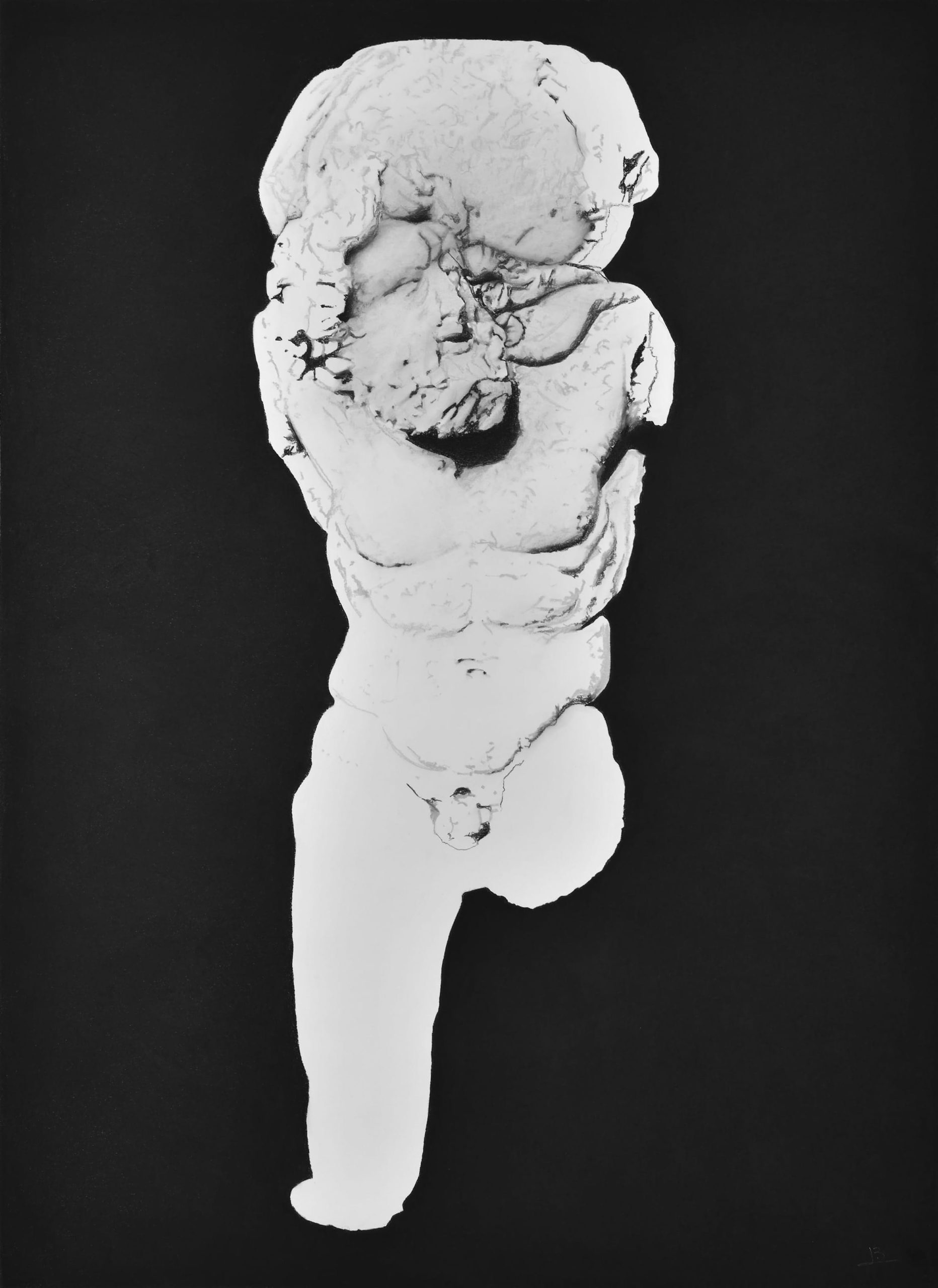
Atlas portant le monde / Atlas Carrying the World, 2021
Dessin aux pigments naturels et fusains, papier Canson 224 g/m2
Drawing with natural pigments and charcoal, Canson paper 224 g/m2
133 x 98 cm (52 3/8 x 38 5/8 in.) encadré / framed
Un artiste de Rhodes, au 1er siècle avant J.-C. a imaginé le géant Atlas, le corps arc-bouté et tendant toutes ses forces pour continuer, quoique amputé par l’usure des siècles, à porter le globe terrestre sur ses épaules.
An artist from Rhodes, in the first century BC, imagined the giant Atlas, his body arched and straining, summons all his strength to continue, through the centuries, carrying the globe on his shoulders.
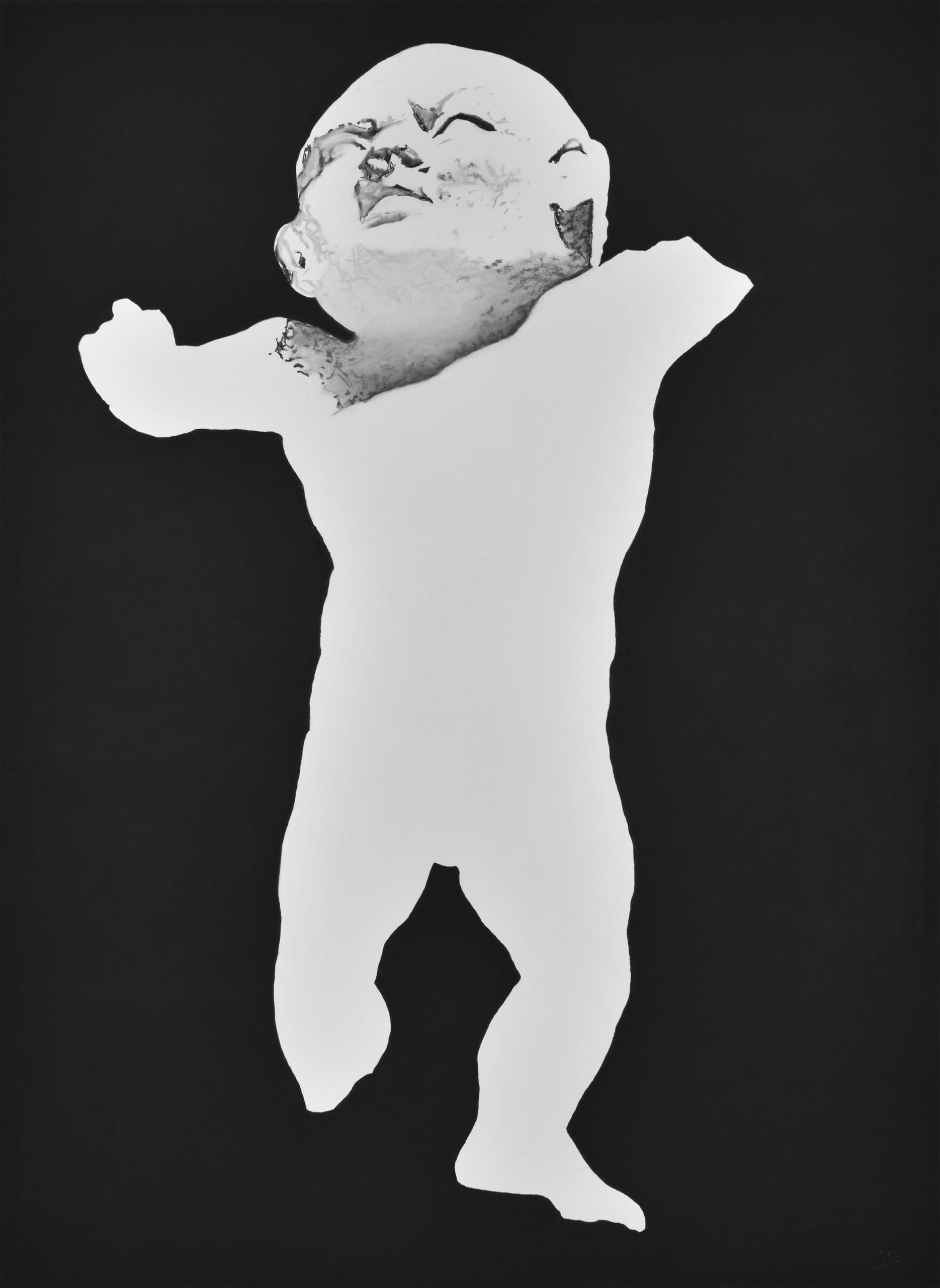
Le Géant / The Giant, 2021
Dessin aux pigments naturels et fusains, papier Canson 224 g/m2
Drawing with natural pigments and charcoal, Canson paper 224 g/m2
133 x 98 cm (52 3/8 x 38 5/8 in.) encadré / framed
D’après une terre cuite réalisée dans l’Alexandrie du 4ème siècle avant J.-C. Ce géant inquiétant, le visage levé vers le ciel, semble défier les lois de la pesanteur, dans un simulacre d’envol.
Inspired by a terracotta made in Alexandria in the fourth century BC, this disturbing giant, with his face raised to the sky, defies the laws of gravity, in a simulated flight.
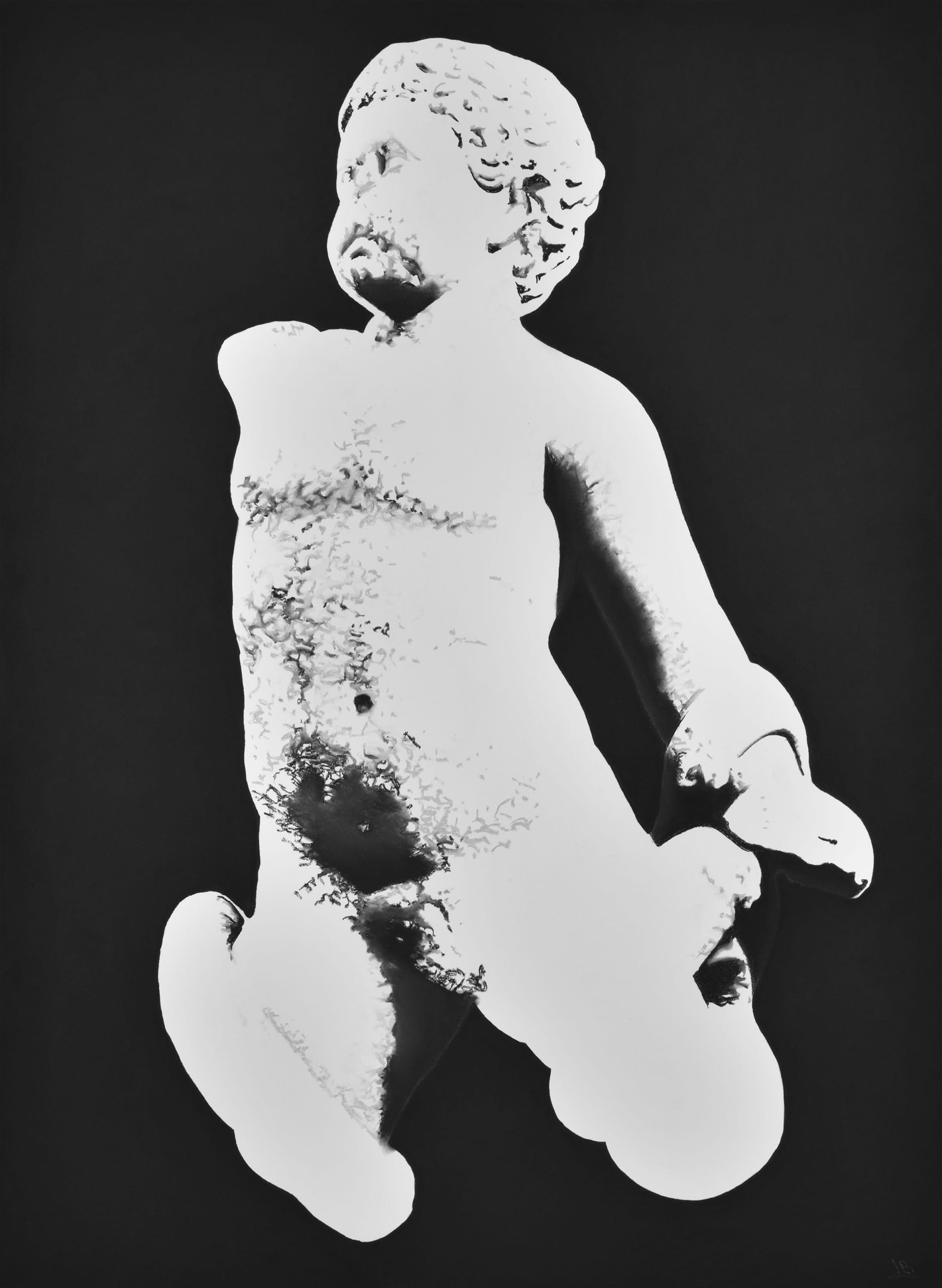
Hercule enfant étouffant les serpents (II) / Hercules as a Child Choking the Snakes (II), 2021
Dessin aux pigments naturels et fusains, papier Canson 224 g/m2
Drawing with natural pigments and charcoal, Canson paper 224 g/m2
133 x 98 cm (52 3/8 x 38 5/8 in.) encadré / framed
L’art hellénistique du 1er ou 2ème siècle a illustré à son tour, l’exploit canonique d’Hercule enfant en le représentant en chérubin athlétique combattant le serpent.
Hellenistic art of the first or second century illustrated, in its turn, the canonical feat of Hercules as a child by representing him as an athletic cherub fighting the snake.
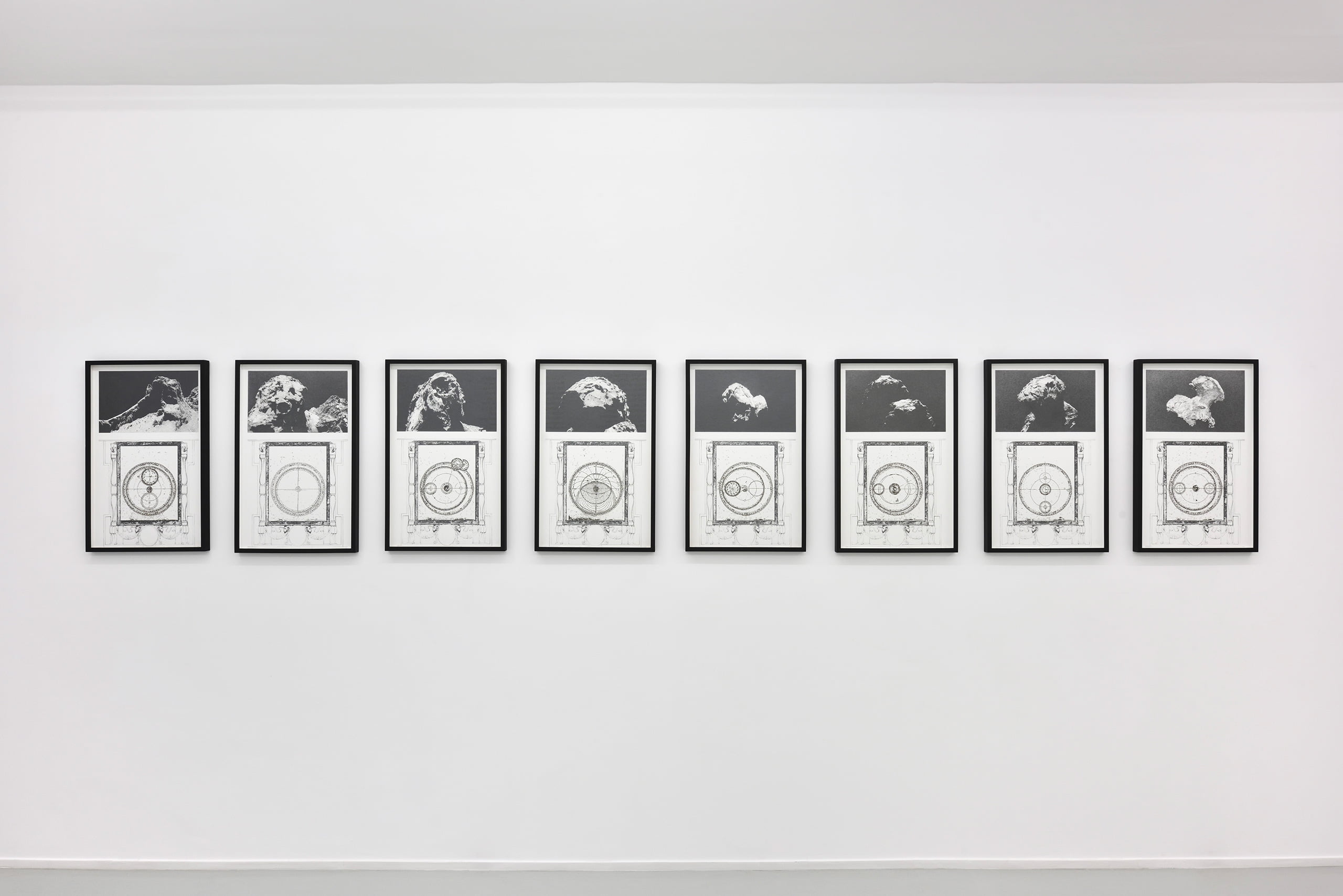
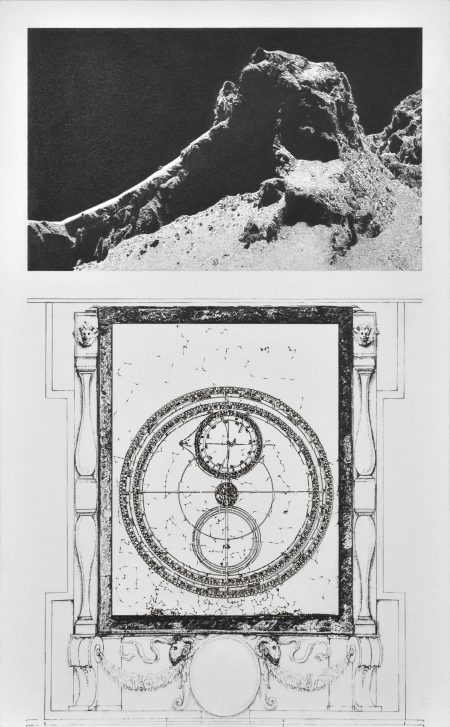
De Sphaera Mundi I, 2019
Dessin à la mine de graphite Faber-Castell, gravure au laser, papier Canson 224 g/m2
Faber-Castell graphite drawing and laser engraving on Canson paper 224 g/m2
66,5 x 41,6 cm (26 1/8 x 16 3/8 in.) encadré / framed
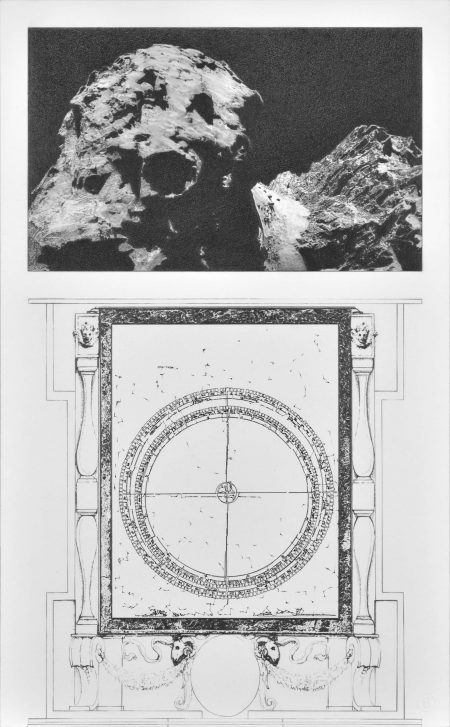
De Sphaera Mundi II, 2019
Dessin à la mine de graphite Faber-Castell, gravure au laser, papier Canson 224 g/m2
Faber-Castell graphite drawing and laser engraving on Canson paper 224 g/m2
66,5 x 41,6 cm (26 1/8 x 16 3/8 in.) encadré / framed
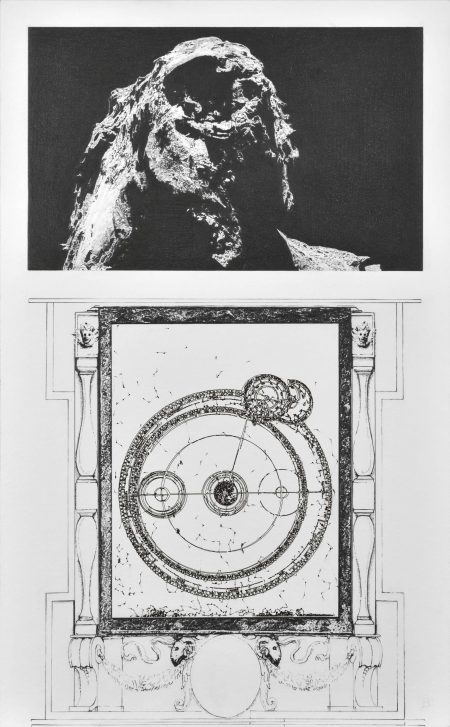
De Sphaera Mundi III, 2019
Dessin à la mine de graphite Faber-Castell, gravure au laser, papier Canson 224 g/m2
Faber-Castell graphite drawing and laser engraving on Canson paper 224 g/m2)
66,5 x 41,6 cm (26 1/8 x 16 3/8 in.) encadré / framed
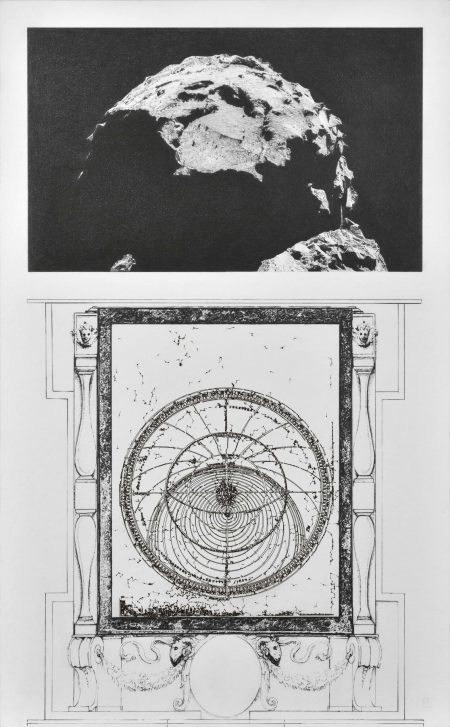
De Sphaera Mundi IV, 2019
Dessin à la mine de graphite Faber-Castell, gravure au laser, papier Canson 224 g/m2
Faber-Castell graphite drawing and laser engraving on Canson paper 224 g/m2
66,5 x 41,6 cm (26 1/8 x 16 3/8 in.) encadré / framed
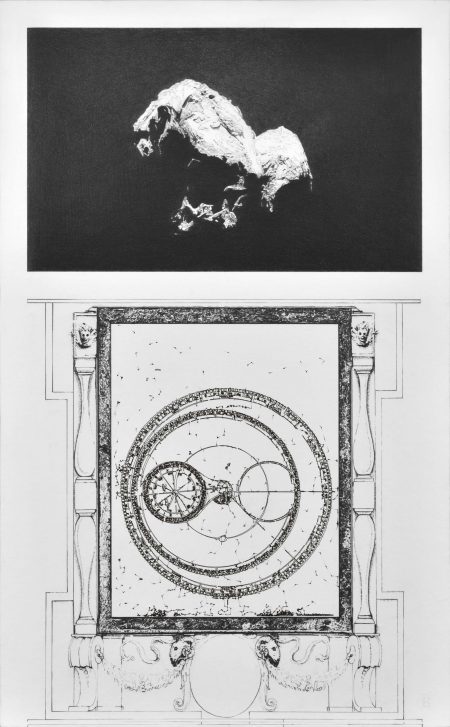
De Sphaera Mundi V, 2019
Dessin à la mine de graphite Faber-Castell, gravure au laser, papier Canson 224 g/m2
Faber-Castell graphite drawing and laser engraving on Canson paper 224 g/m2
66,5 x 41,6 cm (26 1/8 x 16 3/8 in.) encadré / framed
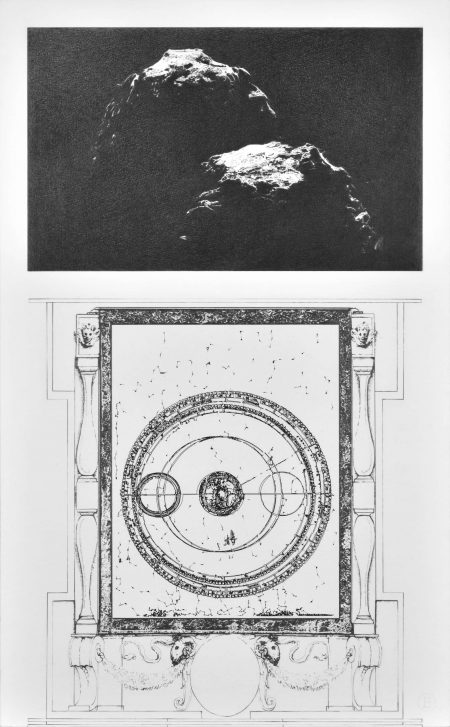
De Sphaera Mundi VI, 2019
Dessin à la mine de graphite Faber-Castell, gravure au laser, papier Canson 224 g/m2
Faber-Castell graphite drawing and laser engraving on Canson paper 224 g/m2
66,5 x 41,6 cm (26 1/8 x 16 3/8 in.) encadré / framed
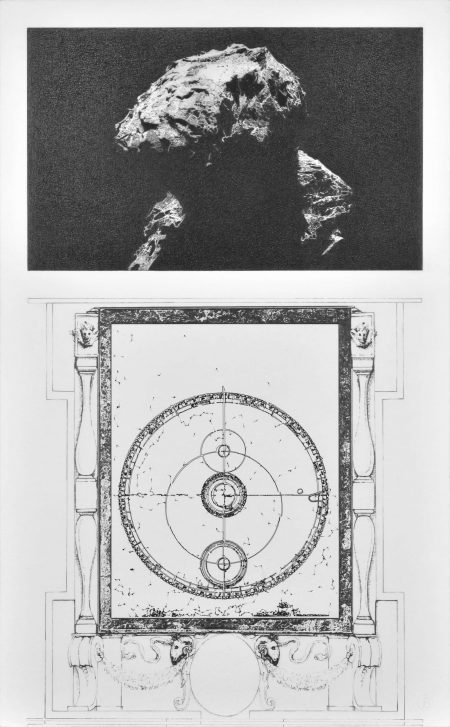
De Sphaera Mundi VII, 2019
Dessin à la mine de graphite Faber-Castell, gravure au laser, papier Canson 224 g/m2
Faber-Castell graphite drawing and laser engraving on Canson paper 224 g/m2
66,5 x 41,6 cm (26 1/8 x 16 3/8 in.) encadré / framed
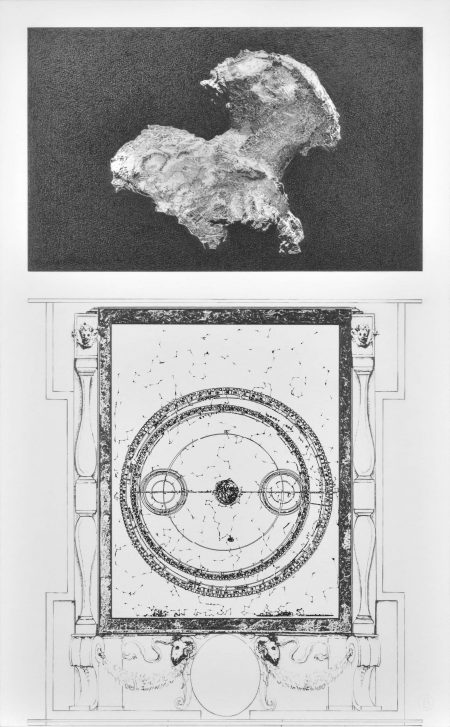
De Sphaera Mundi VIII, 2019
Dessin à la mine de graphite Faber-Castell, gravure au laser, papier Canson 224 g/m2
Faber-Castell graphite drawing and laser engraving on Canson paper 224 g/m2
66,5 x 41,6 cm (26 1/8 x 16 3/8 in.) encadré / framed
De Sphaera Mundi plonge dans le rêve cosmologique qui hante plusieurs œuvres de l’artiste – Paranatellon, Magni Sidera Mundi et Ignis Opus – présentées dans sa précédente exposition Le Ciel nous observe. Des planisphères célestes du XIIème siècle tirés de la « Théorie des Planètes » de Gérard de Crémone servent de socles aux vues d’une Comète d’une haute importance symbolique puisqu’associée à la sonde spatiale Rosetta en orbite depuis 2014 autour de 67 P Churyumov-gerasimenko pour l’observer et collecter des données sur la genèse du système solaire. Dans un précipité spatio-temporel, De Sphaera Mundi télescope d’anciennes cartographies et la plus récente technologie spatiale, l’astrologie médiévale et l’aventure spatiale du XXIème siècle. La mission Rosetta projette dans le futur la mémoire du passé de l’humanité en embarquant un disque inaltérable archivant 1500 langues terrestres comme une nouvelle pierre de Rosette permettant dans l’infini des temps, de déchiffrer les langues des civilisations passées.
De Sphaera Mundi dives into the cosmological dream that haunts several of Bedez’s works—such as Paranatellon, Magni Sidera Mundi, and Ignis Opus—presented in his previous exhibition Le Ciel nous observe (Heaven is watching us). Twelfth-century celestial planispheres from the Theory of the Planets by Gerard of Cremona serve as pedestals for views of a comet, of high symbolic importance since associated with the space probe Rosetta, in orbit since 2014 around 67 P Churyumov-gerasimenko, to observe it and collect data on the genesis of the solar system. In a space-time precipitate, De Sphaera Mundi telescopes ancient cartography and the latest space technology, medieval astrology and twenty-first-century space adventure. The Rosetta mission projects into the future the memory of humanity’s past, by embarking an unalterable disk on which are archived 1,500 terrestrial languages, like a new Rosetta stone allowing in the infinity of time, to decipher the languages of past civilizations.
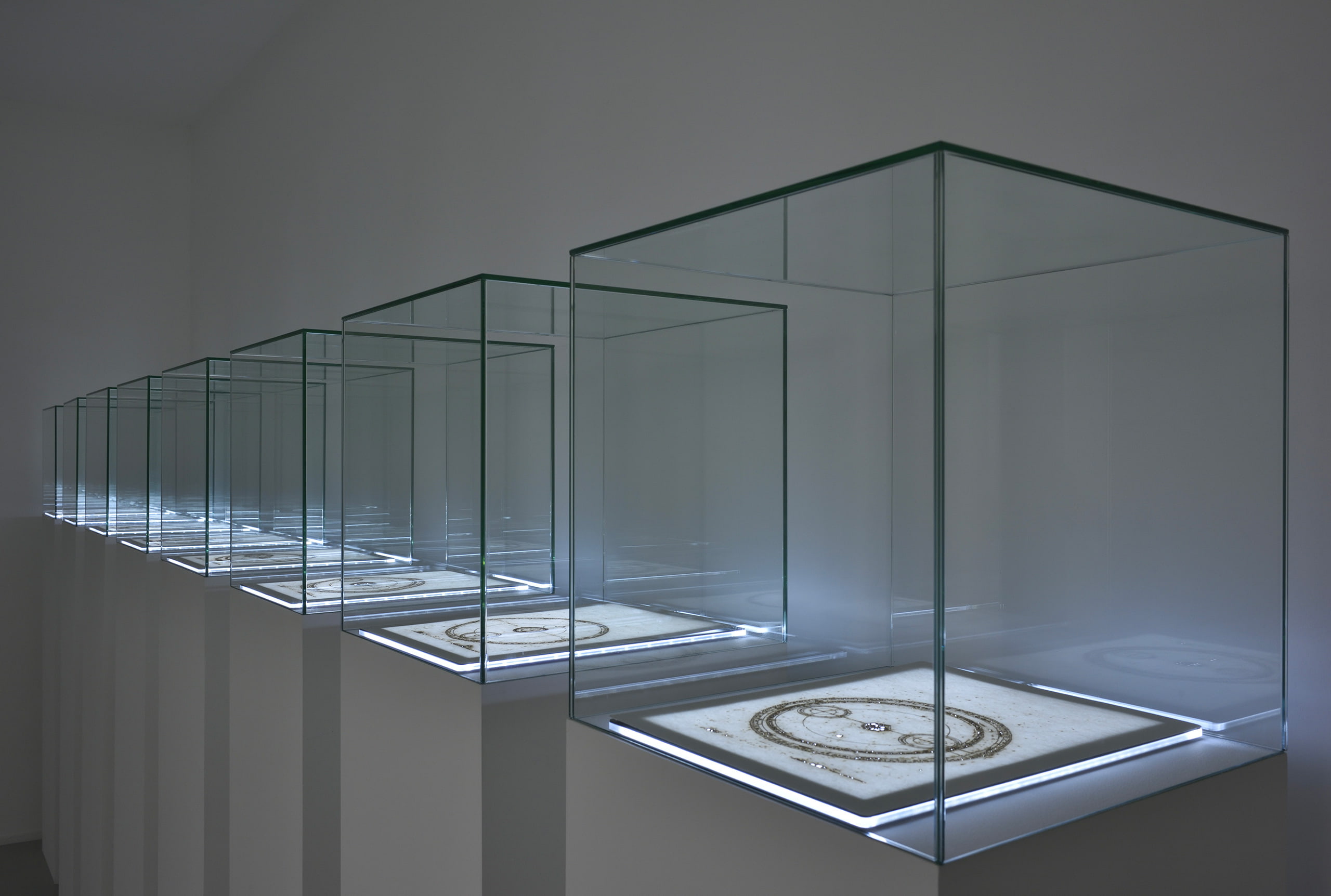
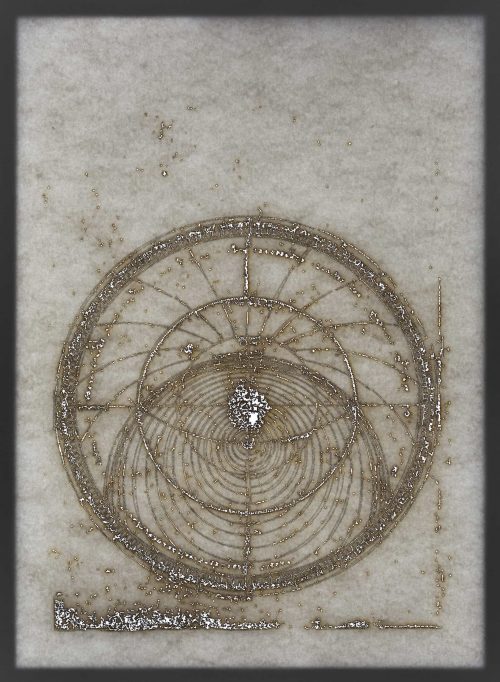
De Sphaera Mundi IV, 2021
Gravure au laser, table lumineuse, papier Canson 224 g/m2
Laser engraving, light table, Canson paper 224 g/m2
36 x 27 cm (14 1/8 x 10 5/8 in.)
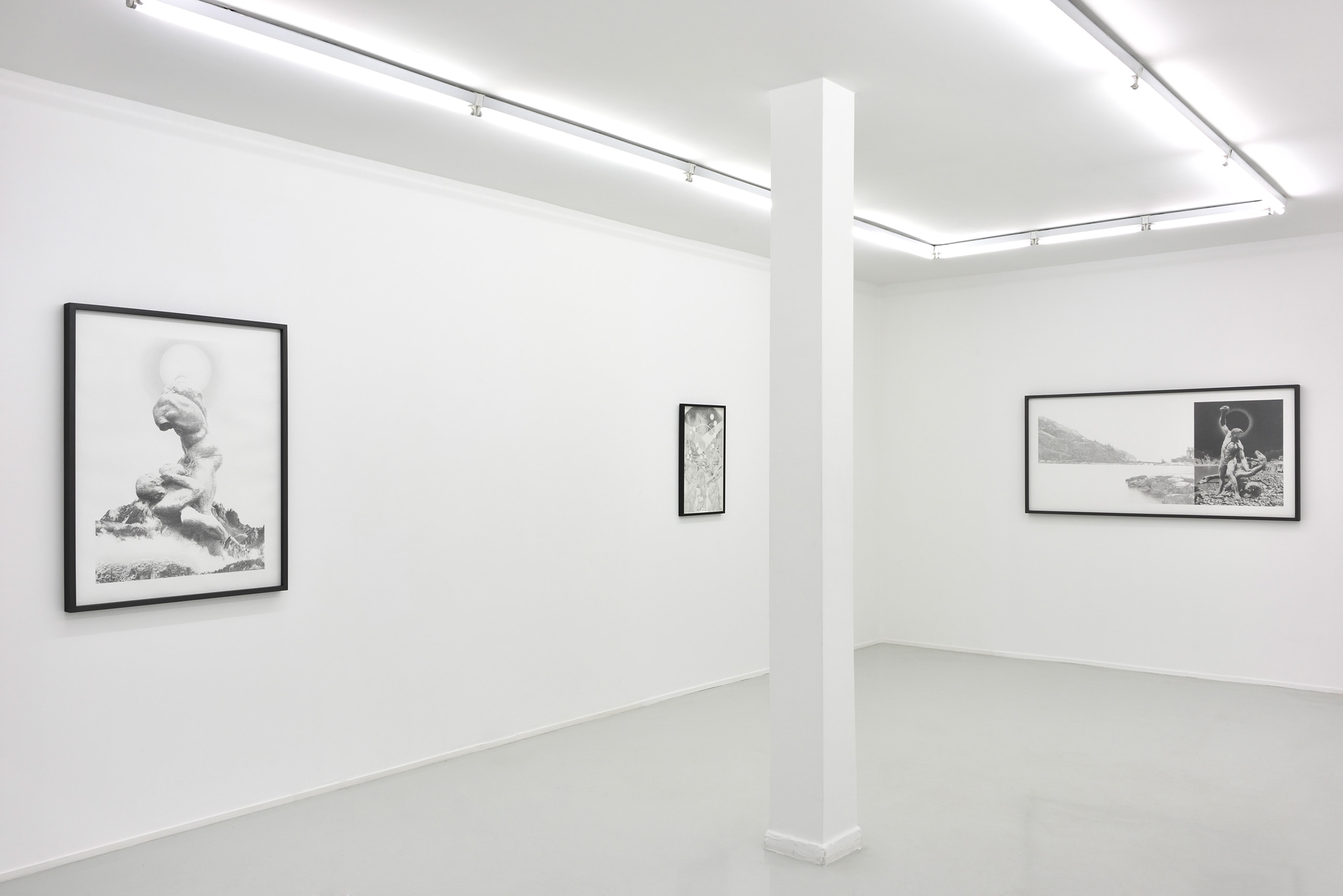
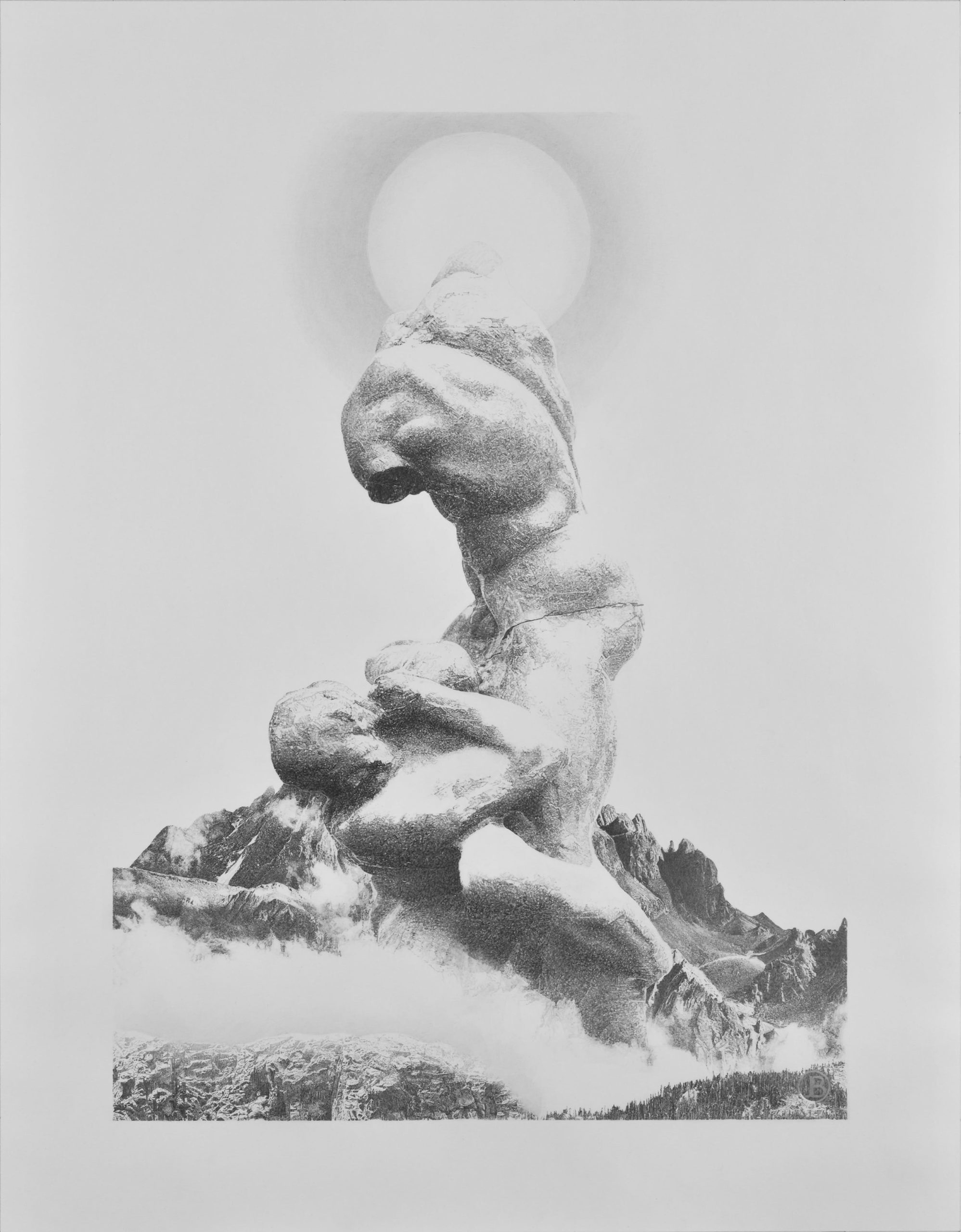
Hercule tuant Cacus avec une massue / Hercules Killing Cacus with a Club, 2021
Dessin à la mine de graphite Faber-Castell, papier Canson 224 g/m2
Drawing with graphite pencil Faber-Castell, Canson paper 224 g/m2
108 x 83,5 cm (42 1/2 x 32 7/8 in.) encadré / framed
Dans ce dessin réalisé d’après une sculpture Michangelo Buonarroti, Hercule enserre dans une étreinte mortelle, le géant à terre ; l’outrage des ans a privé le héros de son intégrité physique et de son arme, sans parvenir à effacer l’impression de puissance et de force consubstantielle au mythe.
In this drawing made after a Michangelo Buonarroti sculpture, Hercules holds the giant on the ground in a deadly embrace; the years have deprived the hero of his physical integrity and his weapon, without erasing the impression of power and strength consubstantial to the myth.
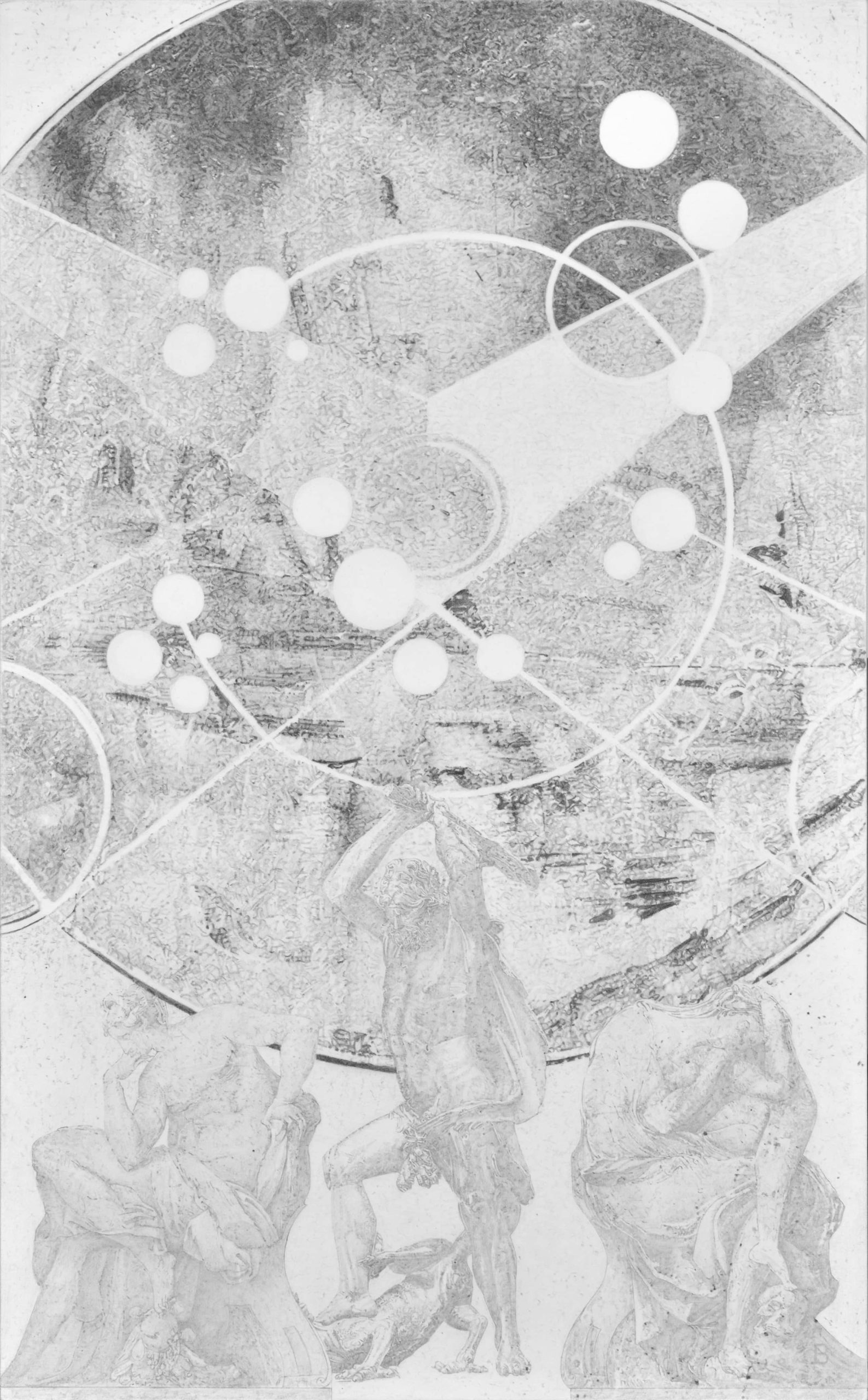
Constellation du dragon / Constellation of the Dragon, 2019
Dessin à la mine de graphite Faber-Castell, papier Canson 224 g/m2
Graphite drawing Faber-Castell on Canson paper 224 g/m2
67 x 42 cm (26 3/8 x 16 1/2 in.) encadré / framed
Cosmologie et mythologie sont étroitement mêlées dans cette représentation à la fois figurative et métaphorique du combat d’Hercule contre le dragon qui gardait les pommes d’or du jardin des Hespérides. Surmontant la scène du combat, une carte du ciel comme une très ancienne cartographie, déploie la constellation du dragon. Comme un envol de bulles, un jeu serpentin de formes sphériques est emporté dans le mouvement de l’immense roue du globe terrestre que soutiennent à la manière de cariatides venues elles aussi du mythe d’Hercule, les nymphes Hespérides, filles du géant Atlas et premières gardiennes des pommes d’or.
Cosmology and mythology are closely intertwined in this figurative and metaphorical representation of Hercules’ fight against the dragon guarding the golden apples of the Garden of the Hesperides. Overlooking the scene of the fight, an ancient map of the sky shows the constellation of the dragon. Like a flight of bubbles, a serpentine play of spherical forms is carried away in the movement of the immense wheel of the terrestrial globe, held up like caryatids by the Hesperides, daughters of the giant Atlas and first guardians of the apples.
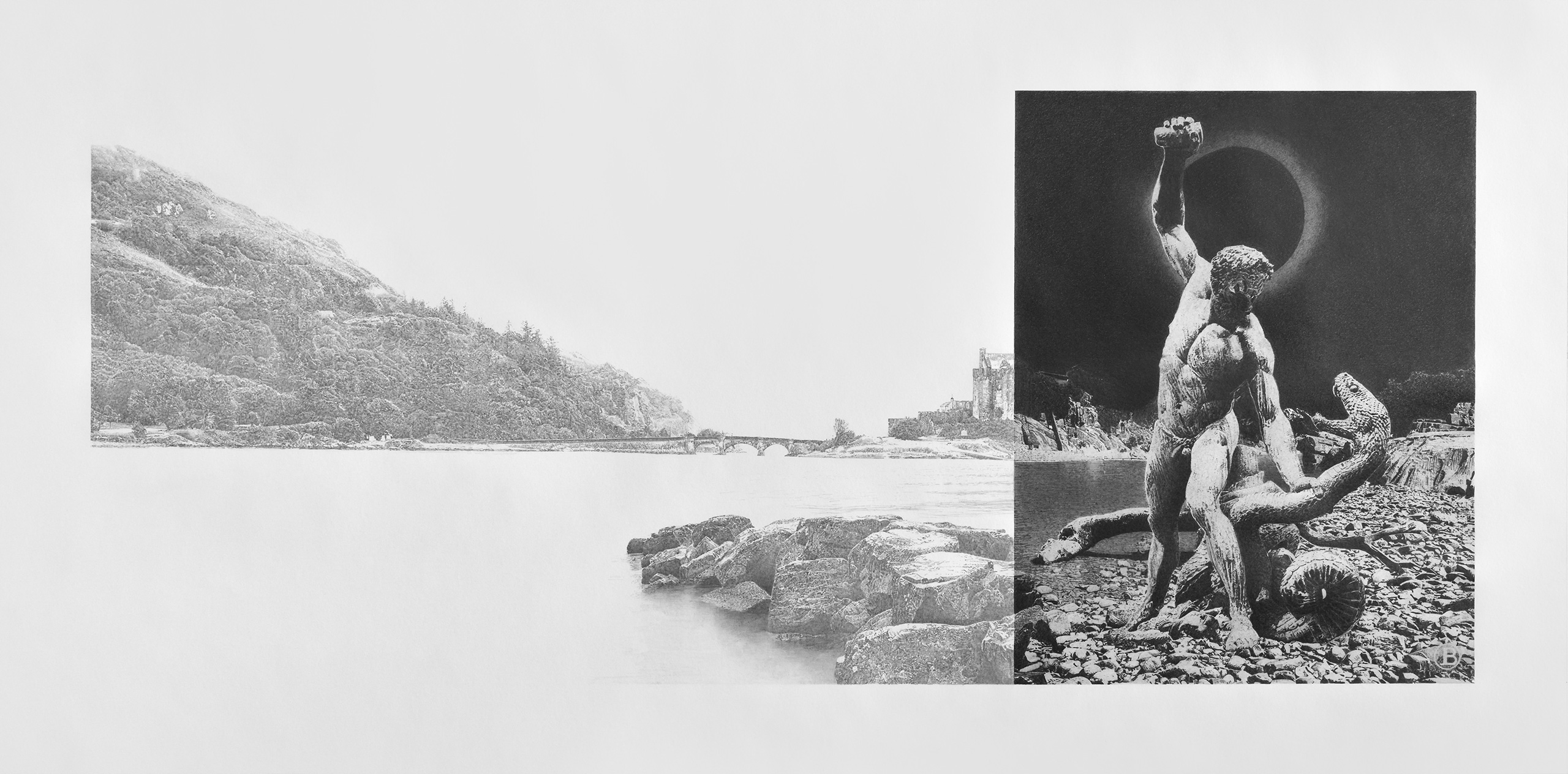
Hercule combattant Achéloüs / Hercules Fighting Achelous, 2020
Dessin à la mine de graphite Faber-Castell, papier Canson 224 g/m2
Drawing with graphite pencil Faber-Castell, Canson paper 224 g/m2
82 x 167 cm (32 1/4 x 65 3/4 in.) framed / encadré
Le dessin d’inspiration panoramique représente un paysage fluvial, une forêt sombre contraste avec une ligne d’horizon plus claire fermée par un pont et un château. Le thème du fleuve ressurgit de manière métaphorique dans l’évocation d’un épisode mythologique opposant Hercule à Achéleous, un des fleuves de la Grèce transformé en dieu capable de se métamorphoser en diverses créatures comme un serpent immense qu’Hercule dut affronter. Comme dans le triptyque précédent, dans un paysage chaotique et ténébreux, un astre noir couronne le demi dieu saisi en pleine fureur guerrière.
The drawing, inspired by a panorama, represents a river landscape, a dark forest contrasting with a lighter horizon line closed by a bridge and a castle. The theme of the river reappears metaphorically in the evocation of a mythological episode opposing Hercules to Achelous, a river god capable of metamorphizing into various creatures, such as a huge snake, vanquished by Hercules. As in the previous triptych, set in a chaotic and dark landscape, a black star crowns the demi-god, captured in full warlike fury.
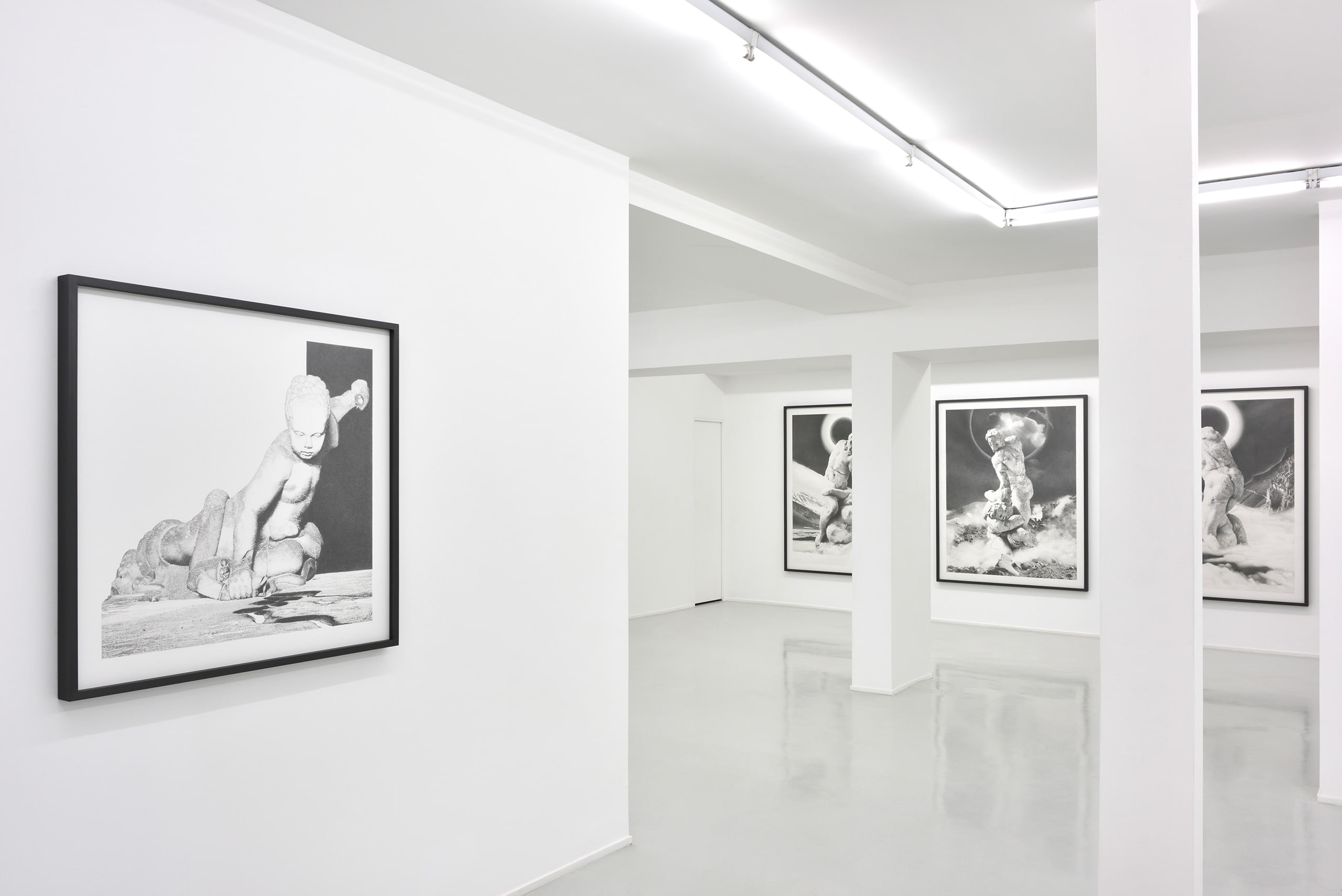
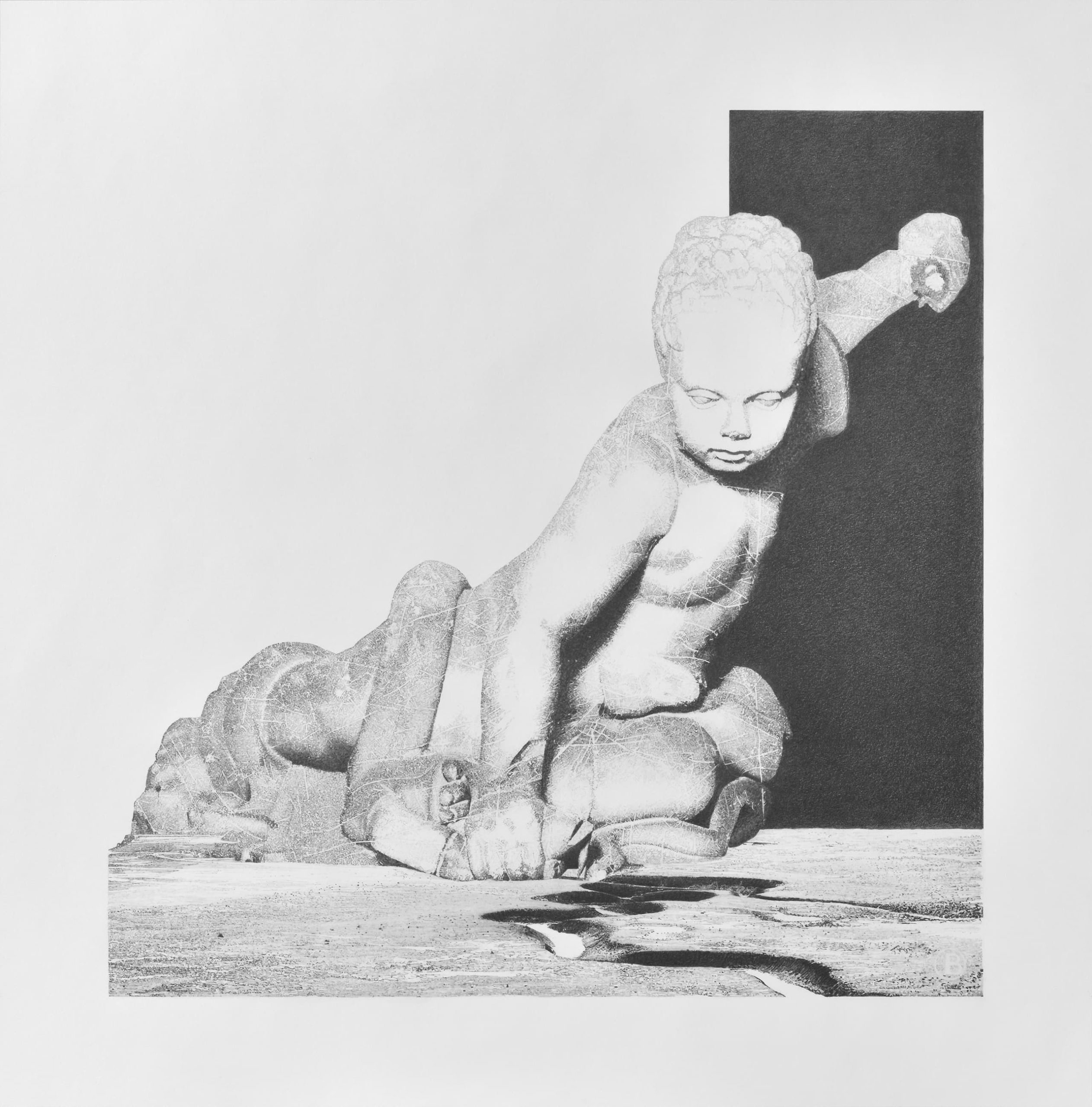
Hercule enfant étouffant les serpents / Hercules as a Child Choking the Snakes, 2020
Dessin à la mine de graphite Faber-Castell, papier Canson 224 g/m2
Drawing with graphite pencil Faber-Castell, Canson paper 224 g/m2
97 x 97 cm (38 1/4 x 38 1/4 in.) encadré / framed
La série des combats d’Hercule est complétée par son premier exploit accompli au berceau, quand il n’était qu’un petit enfant et qu’il étouffa à mains nues, deux énormes et horribles serpents envoyés par la déesse Héra. Le décor est d’une extrême nudité, seule une trace noire et sinueuse au sol porte l’empreinte de la menace mortelle que sa force physique lui permit de déjouer.
The series of depictions of Hercules’ battles concludes with his first feat, accomplished in the cradle when he was only a small child: strangling with his bare hands two enormous, horrible snakes sent by the goddess Hera. The decor is extremely bare, a black, sinuous trace on the ground bearing the imprint of the mortal threat that Hercules’ physical strength enabled him to thwart.
